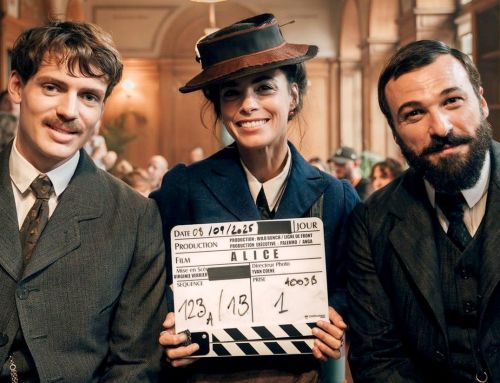“THE MOST BEAUTIFUL BOY IN THE WORLD,” from child stardom to edge of the precipice
For Luchino Visconti’s cinematic adaptation of Thomas Mann’s “Death in Venice,” the filmmaker sought otherworldly beauty in whichever actor he chose to play Tadzio, the young teenager who is the subject of the main character Gustav’s infatuation.
Fifteen-year-old Björn Andrésen was chosen, as his entire persona captivated the filmmaker. As Visconti’s casting director Margaret Krantz states, Andersen was “exquisitely beautiful with a truly photogenic face.”
With its story of beauty and intellectual death (Mann’s novel argues that to put one’s eyes on perfect beauty is to put one’s eyes on death), “Death in Venice” had preoccupied Visconti for years. His desire to find the perfect visual representation of Tadzio had to be a perfect specimen of absolute beauty. To Visconti, Anderson was the perfect actor.
“The Most Beautiful Boy in the World” is the new documentary that gets its title from Luchino Visconti’s public declaration (at his film’s 1971 world premiere) that Anderson was, indeed, “the most beautiful boy in the world.”
This description would follow, shape, and haunt the young actor for the rest of his life.
The film begins with Anderson, now in his sixties and sporting long grey hair and a full grey beard. His mustache is stained with the yellow tint of a heavy smoker and his face is weathered.
His girlfriend is helping him to clean his small apartment, as he is in danger of being evicted due to the wretched state he is living in. It is not squalor, but it is a filthy apartment that he does not keep clean. His kitchen exhaust fans are so filled with grease, it is a fire hazard. She throws out Anderson’s bedding due to bug excrement.
It is sad to see anyone not care about their living conditions, but Anderson makes it even more potent when he and his girlfriend are sharing a drink after ten days of cleaning to prepare the apartment for landlord inspection.
Anderson’s living quarters are saved, and the landlord tells him he has nothing to worry about so the actor and his girlfriend share some wine. The girlfriend says, “nobody should be made to sleep the way you’ve had to.” Anderson replies, “That’s what happens when you don’t feel like a human being.”
Björn Andrésen was made to feel like an object rather than a person. The role in Visconti’s film made Anderson an overnight sensation and international offers poured in but the young actor was bound by a three-year contract with the filmmaker. Legally, Luchino Visconti owned Björn Andrésen’s face. He was famous but he also was someone’s property.
Anderson didn’t like the notoriety and while his grandmother (whom he lived with after the suicide of his mother) loved the fame, her grandson despised it. It was a world he was thrust into by one statement and a world he didn’t care for. Andersen was swept up in a tornado that he could not control.
No fifteen-year-old would be ready for the attention that Andersen received nor would they be able to handle the reality of their situation. Andersen basically had to do what he was told.
He was given pills to keep going on whirlwind tours through Japan. He was taken to clubs and parties and places no young person should have been.
Kristina Lindstrom and Kristian Petri have constructed a dark story around the price of too famous too fast and the lasting effects of unpreparedness.
While Andersen’s career went famously, the actor was haunted by an inner darkness that thwarted any attempt at enjoyment.
The filmmakers examine how this affected Andersen’s relationships. It took the actor years to be there for his daughter Robine, he slowly began to let her into his life once she grew a bit older.
Robine says that Anderson was “an amazing dad in theory but in practice it just didn’t work.”
Alcohol and depression prevented his marriage from working and the death of Andersen’s other child (sudden infant death syndrome) made the actor crumble inside completely. He could not function anymore.
The tragedy of losing a child causes some people to crawl into child-like oblivion. This devastating truth is discovered in a powerful moment. The filmmakers shoot Anderson in profile as he stares into the distance, the decline of his life written on his face.
An ambient score by Filip Leyman and Anna von Hausswolff follows Anderson as he strolls through the streets of Stockholm and the grey, cold, oceanside that becomes an endless sea of memories washes over him.
Out there in the distance is the boy he once was, floating calmly in the waves, insuring Andersen never forgets that there was a time of innocence for the actor. A time before Visconti and the film that stole Anderson’s innocence.
While Anderson continues to act in small roles, his life will likely never be whole again.
This is a man who was never allowed the joys of youth. His was a childhood marked by tragedy and a career that robbed him of his humanness.
Björn Andrésen became a star for a time but quickly faded into myth, an emblem of masculine beauty.
He now lives his life as a faded version of what he once was, a wandering trophy.
“The Most Beautiful Boy in the World” is a strikingly personal look at the price one pays for having faith in those who dangle dreams before their eye.
Film premiered at this year’s Sundance Film Festival.







